A Great British Coastal Liner Empire
Part I – 1913-1939

 Coast Lines Ltd. was founded on 30th September 1913 by the merger of three Liverpool based coastal companies under the title of Powell, Bacon and Hough Lines. 1913 was the year in which some 4.2 million tonnes of cargo cleared the Mersey on coastal voyages compared to twelve million tonnes sailing on foreign bound voyages. Powell, Bacon and Hough Lines was renamed as Coast Lines Ltd. in March 1917 when the merged company was purchased for £800,000 by Sir Owen Philipps (later Lord Kylsant) and his Royal Mail Line as a coastal feeder network for his deep sea ships.
Coast Lines Ltd. was founded on 30th September 1913 by the merger of three Liverpool based coastal companies under the title of Powell, Bacon and Hough Lines. 1913 was the year in which some 4.2 million tonnes of cargo cleared the Mersey on coastal voyages compared to twelve million tonnes sailing on foreign bound voyages. Powell, Bacon and Hough Lines was renamed as Coast Lines Ltd. in March 1917 when the merged company was purchased for £800,000 by Sir Owen Philipps (later Lord Kylsant) and his Royal Mail Line as a coastal feeder network for his deep sea ships.
Liverpool Passengers & Cargo
Transatlantic passengers arriving in Liverpool in 1914 had the choice of a number of good hotels to break their journey including the newly opened Adelphi Hotel, owned by the London, Midland and Scottish Railway (LMS), before continuing on to London and elsewhere in England. Coast Lines later purchased the Atlantic Hotel in Liverpool for their passengers arriving from Belfast and other Irish Sea ports in their coastal passenger vessels before continuing their journey by sea to London on their passenger ships. The loading berths in Liverpool for Coast Lines were in the Bramley Moore Dock, Nelson Dock, North Salisbury Dock, Trafalgar Dock and Victoria Dock. Coast Lines cargo arriving by rail was transferred to the loading berths from the Huskisson rail goods station, adjacent to Huskisson Dock and built in the 1870s with direct connection to Manchester and London.

Powell, Bacon & Hough Lines
The merged company of three long established coastal companies of F. H. Powell & Co. Ltd. (Liverpool to Bristol, South Wales, London and the near Continent), John Bacon Ltd. (Liverpool and Preston to Ireland and Bristol Channel) and Hough Lines (Liverpool to London via West Country ports) was incorporated on 30th September 1913 with a nominal share capital of £1 million in £50 shares, half as Ordinary shares and half as Preference shares. Alfred H. Read (he was knighted in 1919) was appointed as first Chairman of the merged concern of 21 coasters of over 16,000 grt including three small barge-like coasters based in south western coasts. He had started his shipping career with Anchor Line, and had later been made a partner in F. H. Powell & Company. He had been appointed to Mersey Docks and Harbour Board in 1904, and was made Chairman of the Liverpool Steam Ship Owners Association in 1912. The first Board meeting of the company was on 1st October 1913 at Tower Building, Water Street in Liverpool when the steamers of the three fleets were transferred to the new company by Bills of Sale.
F.H. Powell & Co. Ltd. had started a direct Liverpool to London service in 1862, with the steamer Augusta as the first vessel to carry the famous white chevron on a black funnel up the Thames. She also traded to Nantes, Le Havre, Dunkirk and Spanish ports with general cargo outwards and grain and sugar homewards. The company was also known as the Liverpool & Bristol & London Steamship Company or Powell Line for short. In the 1870s, the first of numerous ships with the suffix ‘ful’ to their names was purchased and renamed Cheerful, followed by Truthful, Faithful, Hopeful and Graceful. By the 1880s, a six strong fleet was sailing from Liverpool to the London terminus of Regent’s Canal Wharf, and in the summer Powerful carried a full complement of fifty passengers from Liverpool, and Masterful nearly eighty passengers on their weekly service, fares were 25 shillings with all meals extra. At the new century, Faithful of 1871, Truthful of 1877, Graceful of 1886, Hopeful of 1888 and two smaller cargo only coasters were employed on the Liverpool to London trade. The last two ships for the Powell Line service were Powerful of 1,607 grt completed in July 1903 by Swan, Hunter & Wigham Richardson Ltd. with triple expansion engines by the builder, and Masterful of 1,794 grt completed in November 1905 by the Harkess yard at Middlesbrough with triple expansion engines by Blair of Stockton. They had accommodation for around one hundred passengers, and were equipped with submarine signalling apparatus.
John Bacon Ltd. founded his Bacon Line around 1850 to trade from Liverpool and Preston to Bristol Channel ports and Wexford. He died in 1886 and others took over John Bacon Ltd., founded in 1889, with control obtained by Powell Line in 1910. The fleet had grandiose names such as Sir Walter Bacon, Sir Roger Bacon and Sir Edward Bacon.
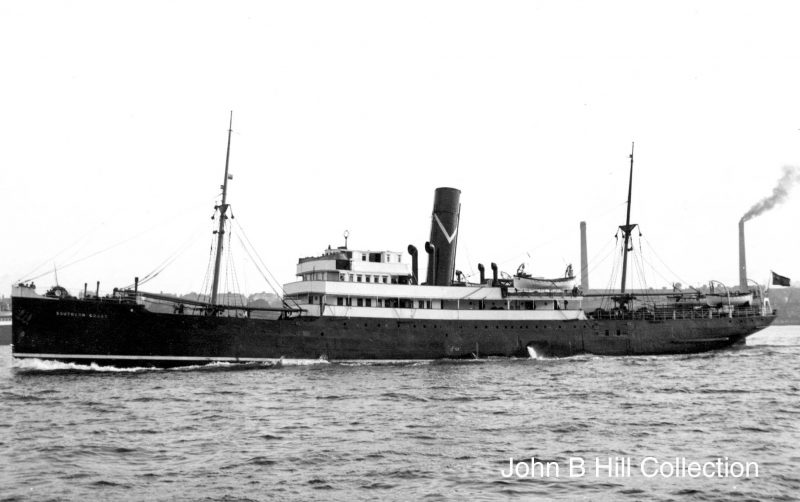
Hough Lines was the smallest of the three fleets that merged together but nevertheless was a big shareholder in the merged company. Samuel Hough entered the shipping business in 1840 working in a Liverpool agent’s office for the British & Irish Steam Packet Company. He began a passenger and cargo service from Liverpool to Falmouth, Plymouth, Southampton, Portsmouth and London in 1856, with steamers that later were named after female members of the Hough family e.g. Mary Hough, Edith Hough, Annie Hough, Maggie Hough and Dorothy Hough. Samuel Hough of 2,000 dwt had accommodation for 75 passengers and was sold just before the merger in 1913 to Burns, Philp & company of Sydney for Pacific trading. Annie Hough dating from 1900 and the larger Dorothy Hough of 1,872 grt from the Grangemouth Dockyard in 1911 with accommodation for 78 passengers were to contribute to the merged fleet. Dorothy Hough as Southern Coast remained on the Liverpool to London service until sold in 1936 to the Falklands Shipping Co. Ltd. and was renamed Lafonia.
The new merged company owned premises at thirteen British ports at Liverpool, Manchester, Bristol, Cardiff, Milford, Portsmouth, Poole, Southampton, Wexford, Port Talbot, Swansea, Plymouth (Victoria Wharves Ltd.), Falmouth and London. New bank accounts were opened at these ports in the name of the new company. It was immediately resolved at the first meeting that the names of the steamers, where necessary, be changed as soon as possible to have the suffix ‘Coast’, and that the new company be publicly known and advertised as ‘Coast Lines’.
H. Powell & Co. Ltd. was the dominant force in the merger and gave the white chevron to the black funnels of the fleet. They contributed five steamers to Coast Lines, John Bacon Ltd. also contributed five steamers, and Hough Lines contributed two steamers. Those coasters with ‘Coast’ suffixes’ to their names by the end of 1913 included Devon Coast, Monmouth Coast, Somerset Coast, Eastern Coast, Sussex Coast, Western Coast, Suffolk Coast, Norfolk Coast, Hampshire Coast, Cornish Coast, Dorset Coast, Gloucester Coast, Pembroke Coast, Gower Coast, Southern Coast, Lancashire Coast, and Northern Coast. Alfred H. Read was appointed manager of all of the vessels in accordance with the Merchant Shipping Act of 1894.
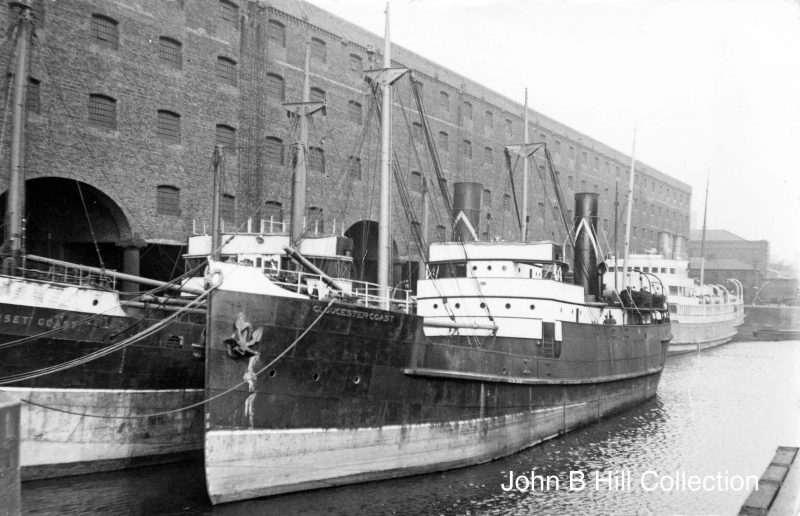
Barges were used to load and offload cargo in South Western ports such as Falmouth, and an additional one was required at Milford Haven and was purchased for £1,100. The first quarterly trading report was good, showing that upwards of 200,000 tonnes of cargo had been carried with freight revenue earned of £78,000. Company director George Pritchard was in Dublin in connection with a seven year agreement with Dublin based Michael Murphy Ltd., regarding the Swansea to Liverpool trade. He also attended a conference at Wexford regarding the company’s trade to that port, and it was resolved to continue trading for a further three months to Wexford, and then to consider ordering a new purpose built steamer for the trade.
This new steamer was launched as Wexford Coast on 31st March 1915, and was immediately requisitioned by the Government for war service. The company had already sustained its first loss during the first six months of war, one of four losses suffered by the company in the Great War :-
24.2.1915 Western Coast torpedoed and sunk 8 miles SE by E1/2E from Beachy Head by U8 while on a voyage from London to Liverpool with general cargo.
7.11.1916 Suffolk Coast captured and sunk by bombs in English Channel by UC17 when 14 miles ESE of Cape Barfleur while on a voyage from the Clyde to Fecamp with general cargo.
17.11.1917 Western Coast torpedoed and sunk in the English Channel 10 miles WSW of the Eddystone Light House by UB40 while on a voyage from Portsmouth to Barry in ballast.
18.6.1918 Norfolk Coast torpedoed and sunk 23 miles SE of Flamborough Head by UB30 while on a voyage from Rouen to the Tyne in ballast, eight crew lost.
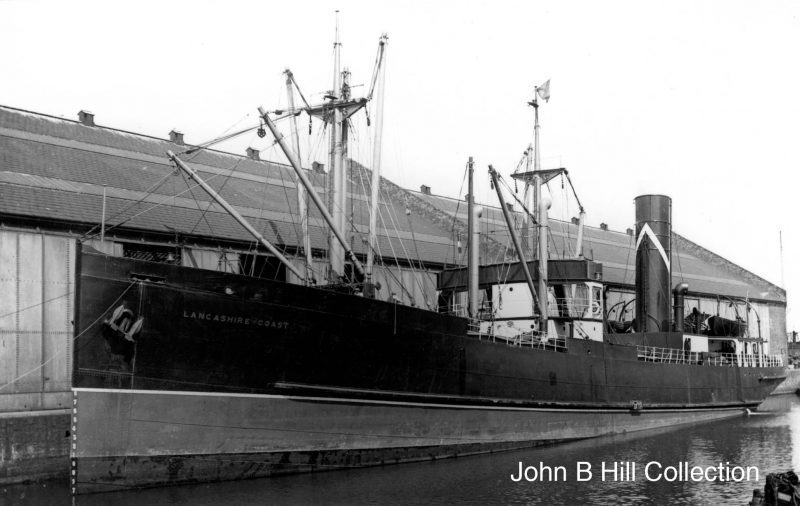
In addition, Somerset Coast and Cornish Coast were lost as a result of war time collisions. At sea, Marconi wireless transmitters had been fitted to four of the largest steamers in 1917 on Eastern Coast, Northern Coast, Southern Coast and Lancashire Coast. The British coastal trade was controlled by Home Trade Transport Committees formed in London and numerous other ports for the purpose of dealing with coastwise traffic in conjunction with the railway companies. The company had moved into new offices in Cunard Building in Liverpool in 1917 to manage a fleet at the end of the war of twenty coasters, the same size of fleet with which it had begun the war.
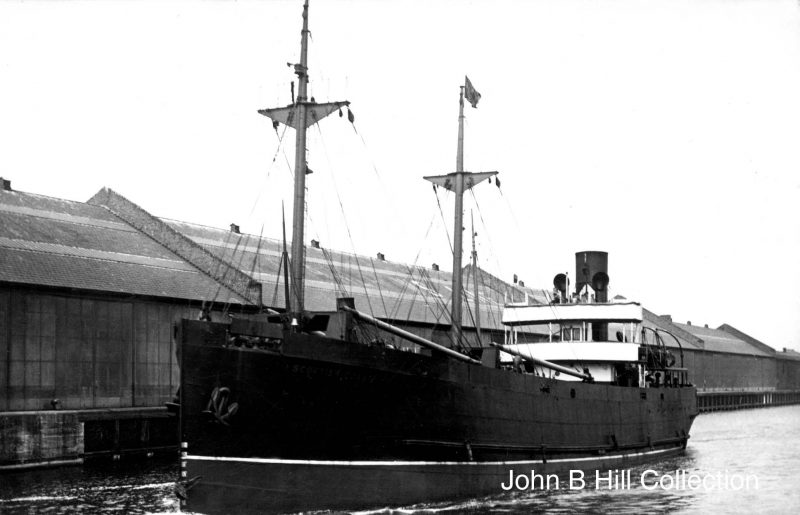
The big Irish Sea coastal passenger and cargo concerns of the Belfast Steamship Co. Ltd., the Burns and Laird coastal companies, and the British and Irish Steam Packet Co. Ltd. were taken over between 1917 and 1922, and are described in full in Part III of this series of articles. Other companies taken over included Rogers & Bright and their Volana Shipping Co. Ltd. in December 1917 with four coasters for £130,000, and traded from Liverpool to South Wales with general cargo, returning with coal and tinplate. Stocks, Turnbull & Co. Ltd. and the London & Kirkcaldy Steamship Co. Ltd. with their two ship fleet was taken over in April 1918 for £100,000 and their weekly service on the East Coast. The Ayr Steam Shipping Co. Ltd. was taken over in September 1919 as part of Laird Line.
Langlands & Sons Ltd. was taken over in September 1919 for £400,000 with nine ships and one in course of construction as Princess Olga, and operated on Glasgow based services to Liverpool, the West of Scotland and the Hebrides, Orkneys, Aberdeen and Leith. This fleet had black hulls with black funnels bearing two closely spaced white bands, but two of the fleet, Princess Alberta of 1905 and Princess Royal of 1912, had grey hulls as they operated summer cruises to the West Highlands of Scotland. They sailed from the Prince’s Landing Stage in Liverpool from the last week in May until the last few days of August on ten day cruises for modest fares of around £15 to £20 depending on occupancy of single, double, three berthed or four berthed cabins. The twin masted good looking steamer Princess Royal of 1,982 grt had 154 cabins with accommodation for 164 First Class and 39 Second Class passengers and required a crew of seventy, but she unfortunately became a war loss on 26th May 1918 three miles WNW of St. Agnes Head in Cornwall while on a voyage from Swansea to Le Havre. Princess Ena, Princess Irma, Princess Beatrice, Princess Melita, Princess Olga, Princess Helena, Princess Thyra and Princess Louise kept their ‘Princess’ names for a few months before being renamed with ‘Coast’ names in 1920.
The Little Western Steamship Co. Ltd., set up in the 1890s, was taken over in March 1920 with three coasters for £160,000 on Penzance and Newport to London services. George Bazeley & Sons of Penzance had begun trading in 1875 with the first steamer purchased two years later. The London Welsh Steamship Co. Ltd., set up in 1908, was taken over in 1923 with two ships for £55,000 acquired from Furness, Withy & Co. Ltd. on Cardiff, Swansea and Llanelli services to London. The earliest record of its trading from Cardiff to London was in 1864. The Grahamston Shipping Co. Ltd. and their one ship was taken over in 1923 by Burns and Laird Lines Ltd.
Michael Murphy Ltd. of Dublin was taken over in 1926 and was merged into the B + I, as was the Murphy owned Dublin General Steam Shipping Co. Ltd. Michael Murphy (later knighted) had founded both firms in Dublin in the 1870s, and he built five of his steamers at the Liffey Dockyard, and was Chairman of Dublin Port & Docks Board in 1903. He had died shortly before the sale to Coast Lines, and the goodwill of the Liverpool to Bristol Channel trade and two coasters, Enda and Patricia, was purchased by Coast Lines in June 1929 for £10,000. M. J. Begg & Co. Ltd., his Cardiff coal exporters, were also included in the deal and were wound up in 1932.
The Dundalk and Newry Steam Packet Co. Ltd. was taken over by the B + I in 1926, and had been formed by an amalgamation of two earlier companies serving Dundalk and Newry in 1871. Three of four old steamers were immediately sent for scrapping and only Iveagh built back in 1892 on the Clyde lasted three more years before being broken up. The West Scotland and Hebridean services of David MacBrayne Ltd. were taken over jointly by Coast Lines and the London, Midland & Scottish Railway Company (LMS), but operated as before without much interaction from either new owner, save for an occasional transfer.
The Antrim Iron Ore Co. Ltd. was taken over in 1929 with regular passenger and cargo services from Belfast to the Tyne and the Tees via Stornoway, Dundee and Leith for £19,000. Two coasters, Glentaise and Glendun, were acquired from this unique trade of Ulster iron ore shipments to the Tyne and the Tees and were renamed Antrim Coast and Aberdeen Coast. The Coast Lines fleet in 1933 numbered 35 steamers and one motor coaster, Truro Trader. All except three barges had ‘Coast’ suffix names as a result of the expansion of the fleet by the acquisition of smaller British coastal companies.
The Kylsant Fiasco
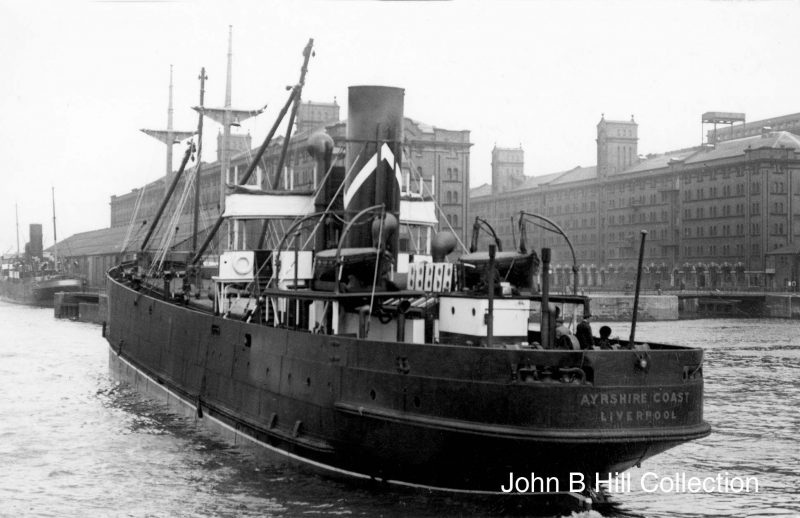
Lord Kylsant, formerly Sir Owen Philipps, had acquired Coast Lines in March 1917 for £800,000 for his Royal Mail Group as a coastal feeder network service for their deep sea ships. Sir Owen Philipps became Chairman, Sir Alfred Read was appointed Managing Director, with Lord Pirrie, Chairman of Harland & Wolff Ltd., the Belfast shipbuilders, as the only other director of Coast Lines. All of the other directors resigned from the Board, and were compensated to the tune of £700 each for loss of office. The Royal Mail Line Group then ordered thirty passenger liners, many of them expensive motorships, and took over 77 standard war design cargo vessels from Harland & Wolff Ltd. and other shipbuilders in 1919. Lord Kylsant raised £12 million in 1920 and an equal amount in 1921 to pay for them and made application for a Government loan under the Trade Facilities Act of 1921 for another big loan. A further £25 million was raised at the end of 1922, all of these loans taken at 6% interest. The interest of well over £1.25 million per year plus the repayments of this colossal debt that was imposed on the Royal Mail Line Group in the very poor freight rates of the 1920s could not be sustained, and it would have taken an enormous upswing in freight rates in 1928/29 to save it. Instead, the opposite happened with the deepest and most severe fall in freight rates ever experienced in the western world.

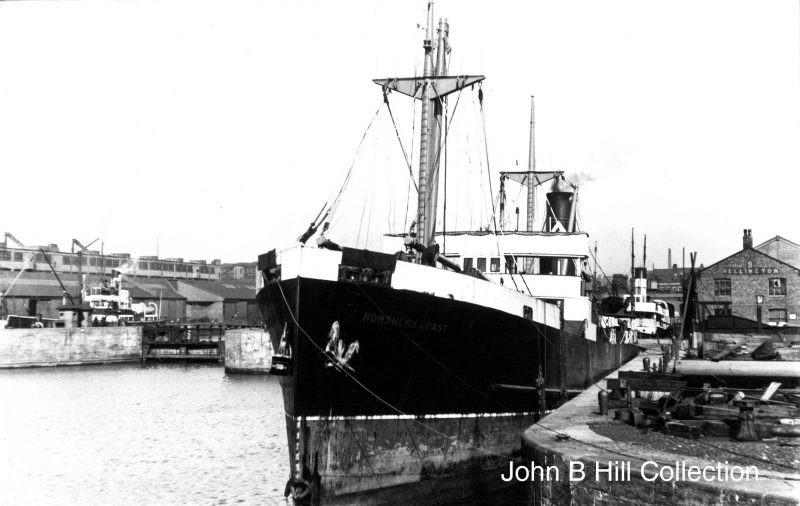
On 1st January 1927, Lord Kylsant of Royal Mail Line, and Chairman of Coast Lines throughout the 1920s, purchased White Star Line For Transatlantic trading together with large blocks of shares and majority control in Shaw, Savill & Albion Co. Ltd. and the Australian Commonwealth Line for Antipodean trading, and thus expanded his shipping empire, which included the Shire Line, Glen Line, Elder Dempster Line, Union – Castle Line, Pacific Steam Navigation Company (PSNC), Nelson Line, Lamport & Holt, Moss Steamship Co. Ltd., J. & P. Hutchinson and many other British shipping companies, amounting to 15% of the British Merchant Navy. The loss of the Lamport & Holt passenger liner Vestris on 12th November 1928 with 112 American lives lost created a lot of adverse publicity for Royal Mail Line in the U.S.A. and Britain, and led to the withdrawal of the New York to South America passenger service and a big loss of revenue. The Government then refused to allow the last fixed repayment of the Trade Facilities Act loan to be extended beyond 31st December 1928, and Lord Kylsant had a spectacular business failure in 1930 and spent a year in gaol, due mostly to having issued a grossly misleading and false prospectus in 1928 to prospective shareholders. He was convicted under the Larceny Act, having attended his last Coast Lines Board meeting in November 1930. He resigned as Chairman of Coast Lines with Sir Alfred Read reappointed as Chairman.
Lord Runciman was appointed Deputy Chairman of Royal Mail Line in June 1930, and also as a director of all of its subsidiaries including Coast Lines. He was one of the four voting trustees who had agreed to take on the enormous task of salvaging what they could from the wreck of the Royal Mail Group. Their task was very complex as Lord Kylsant had established very large cross-holdings linking every company in the Group, and as one company was extricated from the mess it had a ‘knock-on’ effect on all of the others.
Lord Kylsant had been gradually resigning as Chairman of all of the individual companies within the Royal Mail Group from August 1930. After his release from prison, he returned to his Pembrokeshire estate, where he died on 10th June 1937. Sir Alfred Read had been distancing Coast Lines from Lord Kylsant in the late 1920s, as he knew the enormous debts that had been built up by Lord Kylsant and his Royal Mail Group. In the late summer of 1930, Sir Alfred Read was discussing with his personal financial adviser, Sir John Mann, a Glasgow accountant, how to raise money independent of the control of the voting trustees of Royal Mail Line Group. However, until profitability returned to many of these companies in the Group at the end of the Depression, the unscrambling process was ‘on hold’. This applied to Coast Lines and until a profit of £359,644 was turned in for 1934, the highest since 1921, no bidders came along. This made possible the resumption of Preference share dividend in May 1935, and the sale of Coast Lines was looking like a real possibility towards the end of 1935. In November of that year, Hambros Bank formally purchased two million Ordinary Coast Lines shares for 16 shillings (80p) each for a total of £1.6 million, and Coast Lines was once again on a sound financial basis, independent of Royal Mail Line.
Further Take-Overs In The 1930s
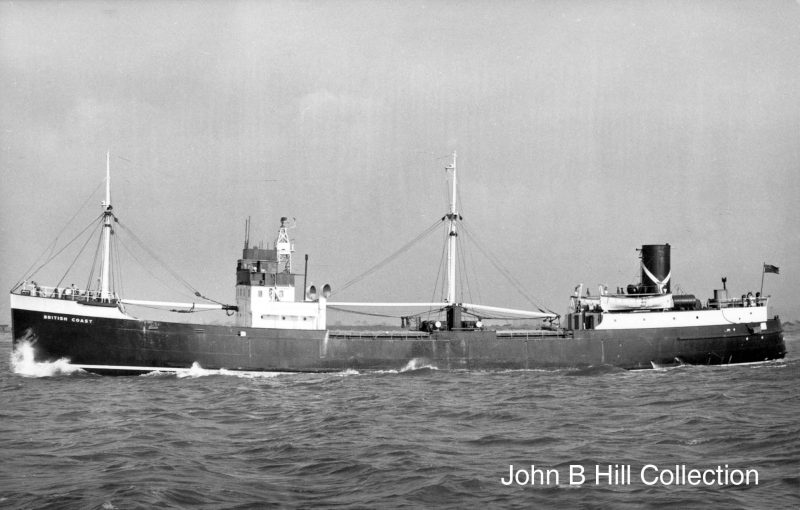
The depths of the Depression saw Sir Alfred Read continue his take-overs of smaller British coastal companies for Coast Lines. The Clyde and Campbeltown Shipping Co. Ltd. was acquired in 1931, and unlike all the other companies in Coast Lines take-overs, was eventually sold on in 1949 to the Caledonian Steam Packet Co. Ltd. via the British Transport Commission. Henry Burden Junior & Co. Ltd. with two coasters was acquired in 1936 for £20,000. The Sligo Navigation Co. Ltd. was acquired by Burns and Laird Lines in 1936, and also in the same year the Plymouth, Channel Islands and Brittany Steamship Co. Ltd. was acquired with one coaster. On 1st July 1937, Sir Alfred Read introduced a new houseflag for Coast Lines, bringing together the colours of all three founding companies into five horizontal blue, white and red bands with blue central ‘CL’.
In 1937, the London and Channel Islands Steamship Co. Ltd., managed by Cheesewright & Ford, with six coasters was taken over for £67,052. They operated passenger and cargo services to all of the Channel Islands as well as on occasional tramping. The company was renamed as the British Channel Islands Shipping Co. Ltd., with the tramping arm hived off in 1943 as British Channel Traders Ltd., renamed Queenship Navigation Ltd. in 1947 as all of their ships had ‘Queen’ suffixes to their names e.g. Channel Queen, Norman Queen and Foam Queen. Anglesey Coast was transferred at the start of 1937 to British Channel Islands Shipping Co. Ltd. and renamed Norman Queen, and wore their yellow funnel with a black top separated by a narrow blue band. Channel Queen, Coral Queen and Tudor Queen were built with finance from the Shipping Loan Bill of 1939. Tudor Queen was, in fact, the prototype of a class of ten war built sisters, five from John Lewis & Sons Ltd. at Aberdeen and four from George Brown & Co. Ltd. of Greenock, and one from Coast Lines’ yard at Ardrossan.
In 1939, Fisher Renwick Manchester-London Steamers Ltd., originally based in Newcastle, was taken over. The company had been founded by George Renwick and Joseph Fisher, with the Renwick family paying for a large war memorial in the Haymarket in Newcastle in gratitude for their four sons returning safely from World War I when so many families lost all or some of their sons. The Fisher family had moved to Manchester in 1894 on the opening of the Manchester Ship Canal, also founding Manchester Dry Docks and a coastal general cargo trade from Manchester to London. The steamers Cuirassier, Sentry and Sapper were renamed as Thames Coast, Medway Coast and Avon Coast respectively.
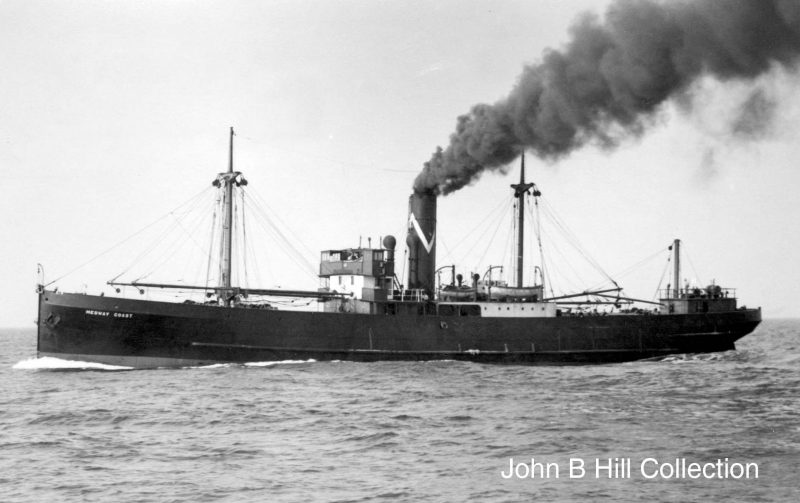
Dutch motor coaster owners had built many new motor coasters from the early 1920s in co-operation with the shipbuilders of Groningen in North Holland, and their economy of operation had made big inroads into the British coastal trade. The low freight rates obtainable in the coastal trades during the Depression meant motor coasters could not be delayed any further by Coast Lines. The first of twenty motor coasters for Coast Lines was accordingly launched at Ardrossan Dockyard as Fife Coast in 1933. The Ardrossan yard had been taken over jointly during the early years of the Depression by Coast Lines and engine builders John G. Kincaid & Co. Ltd. of Greenock.
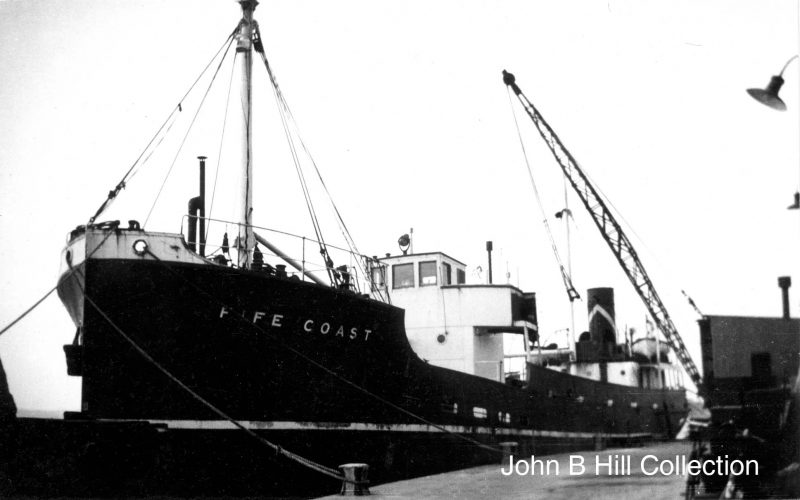
Although small motor barges and tenders had been used before at Falmouth, Plymouth and Truro e.g. Truro Trader, the first Kincaid built six cylinder diesel engine in Fife Coast was not a success, and her sister Carrick Coast of 1934 was given an Atlas four cylinder diesel engine built in Sweden and gave a service speed of 9.5 knots. Fife Coast was accordingly re-engined soon afterwards. Four shelterdecker motor coasters for the London to Liverpool service of Coast Lines were then completed as British Coast, Atlantic Coast, Pacific Coast and Ocean Coast from the Leith yard of Henry Robb Ltd. and from Group member Ardrossan Dockyard Ltd. They had accommodation for twelve passengers, and with their diesel engines manufactured by British Auxiliaries Ltd. of Glasgow and powered twin propellers. They were bridge ‘midships, engines aft vessels with two holds, two masts, with three hatches served by six derricks of between three and eight tonnes capacity. They replaced older coastal steamers that had become uneconomic during the Depression and had been sold e.g. Norfolk Coast, Gower Coast, Fife Coast, Antrim Coast, Devon Coast, Aberdeen Coast, Pentland Coast, Cornish Coast, Moray Coast, Gloucester Coast, Southern Coast, Hampshire Coast, Welsh Coast and Kilkenny. Six motor coasters from Dutch shipyards completed the first batch of twenty Coast Lines motor coasters.
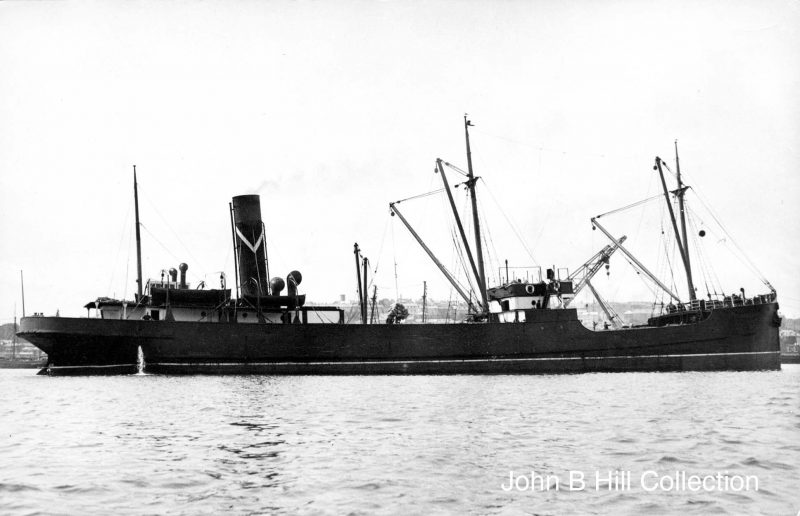
Coastal cruising had been the role of the twin funnelled Killarney in the 1920s, formerly the passenger steamer Magic built back in 1893 by Harland & Wolff Ltd. and renamed Classic in 1918. She served in summer as a cruise ship from Liverpool to the Western Isles and Hebrides and was laid up at Liverpool in winter. She continued in the cruising trade until the outbreak of war in September 1939. After serving with distinction at the evacuation of Dunkirk, and following strenuous war service on the Irish Sea she was sold to Greek owners as Atttiki just after the end of the war. She was replaced by another former Belfast passenger steamer, whose approval for such a conversion had already been made by the Board of Coast Lines in October 1938. This was Lady Connaught, formerly the single funnelled Patriotic of 1911, which had been transferred to the B + I in 1930 as the twin funnelled Lady Leinster and renamed as Lady Connaught in 1938. The time was not quite right for further coastal cruising just before the war, but she was duly converted after the war and started cruising from Liverpool on 20th June 1947 as the single funnelled Lady Killarney, her dummy funnel having been removed during the war.
The Liverpool to London coastal voyages of Southern Coast, formerly Dorothy Hough, and Western Coast, formerly War Leven of 1919, could also be enjoyed as a coastal cruise of ten days duration during the inter-war years. They sailed from Liverpool on a Saturday and called at Plymouth southbound with a call at Dublin on the return voyage. Southern Coast had accommodation for 78 passengers and her public rooms were spacious and popular with passengers. However, the introduction of motor coaches towards the end of the Depression killed off most of the trade, and she was withdrawn from service in 1936 and sold to the Falklands Islands Shipping Co. Ltd. and renamed Lafonia. The motor coach also killed off the Newcastle to London passenger trade of the Tyne-Tees Steam Shipping Co. Ltd., with their ‘crack’ coastal liners Hadrian and Bernicia laid up at the end of 1932 and sold in 1933.
Passenger tickets for cruises, coastal voyages and the Group Irish Sea passenger services could be purchased at the Group booking office in Regent Street in London, whose neighbour next door was the British and Irish Travel Agency Ltd. Coast Lines office in Liverpool also acted as agents for the Sligo Navigation Co. Ltd., acquired by Burns and Laird Lines in 1936, with reciprocal arrangements in place at Sligo, Westport and Ballina.
Freight shipments began to increase rapidly from 1938 onwards for both ICI with chemical traffic and for Tate & Lyle with sugar. The possibility of some form of co-ordination of interests on the Irish Sea with the London, Midland & Scottish Railway (LMS) and the Great Western Railway to give economy of working was agreed by both Sir Alfred Read and the Chairmen of the railway companies and the railway executive committee. In the two years before the outbreak of war four larger coasters were transferred from the B + I fleet to Coast Lines to cope with the increased trade and were renamed as Brittany Coast, Kerry Coast, Galway Coast and Glamorgan Coast.
The standing conference of the Railway Executive of the railway companies and the coastal liner companies was formed in the mid 1930s, with meetings minuted and correspondence recorded. The Coast Lines Seaways (CLS) cargo services had been rapidly increased in number, and were fully represented in this conference, which also continued in post-war years after the end of the impending war with Germany.
A new air venture was entered into a few months before the outbreak of war in September 1939 by a purchase of shares to the value of £6,809 in West Coast Airways (Holdings) Ltd. This company was set up with a capital of £50,000 to operate air services to Eire from the West coast of England. LMS Railway took half of the shares, British & Foreign Aviation Ltd. 34.5%, and Coast Lines and the Great Western Railway 7.75% each.
The Coast Lines Board was also negotiating in 1939 for the purchase of four further shipping companies. These were Bristol Steam Navigation Co. Ltd. (unsuccessful), Palgrave Murphy & Co. Ltd. of Dublin (unsuccessful), Robert Gilchrist & Co. Ltd. (successful in 1941), and the Belfast, Mersey and Manchester Steamship Co. Ltd. of Lawther & Mack (successful in 1945). Coast Lines dividends for the years after the Depression leading up to 1939 were modest in the region of 3%. The Group fleet, including all of its subsidiaries, numbered a huge fleet of 86 vessels on the outbreak of war on 3rd September 1939.
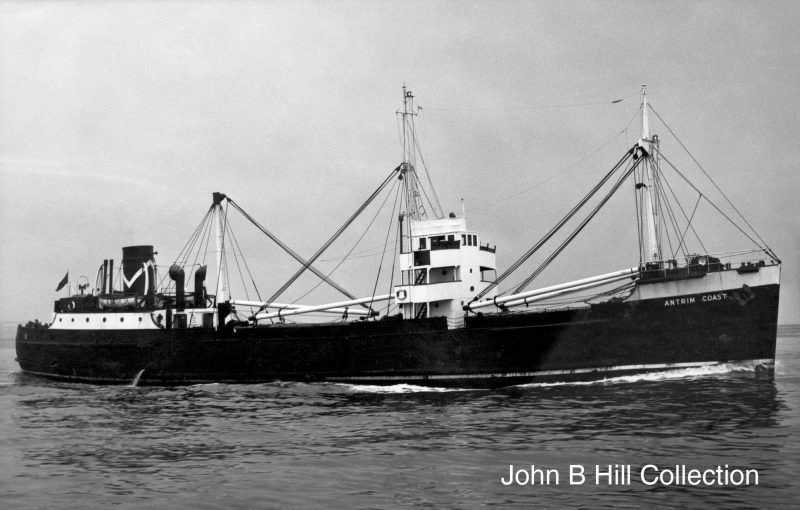
Continued next month …




Comments
Sorry, comments are closed for this item